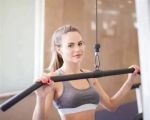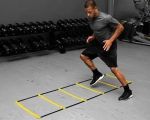1. Building Your Home Gym: The Perfect Fitness Space
When I first decided to create a home gym, I had no idea where to start. Like many people, I was tired of the crowded gym and the hassle of commuting, but I still wanted the motivation and convenience that only a gym could offer. What I soon realized was that building a home gym isn't just about throwing a few weights and a treadmill in a room. It’s about creating a space that is functional, motivating, and conducive to my fitness goals. Let me walk you through the process of how I set up my very own home gym, and share some tips I learned along the way.
1.1. Define Your Fitness Goals
The first step in designing a home gym is figuring out your fitness goals. When I started, my focus was on weight training and cardio, but it’s important to consider your specific fitness needs. Are you looking to build muscle, lose weight, improve flexibility, or practice yoga? Your fitness goals will dictate the type of equipment and layout you need for your space.
For example, if you're into strength training, you'll want to invest in dumbbells, barbells, and maybe a bench press. On the other hand, if you’re focused on flexibility and mobility, you might prioritize yoga mats, resistance bands, and foam rollers.
1.2. Consider Space and Layout
One of the challenges I faced was figuring out where to put everything. I didn’t have a huge basement or extra room, so I had to get creative with the space I had. It’s important to assess the size of the space you plan to dedicate to your gym. Whether it’s a spare bedroom, a corner of your living room, or even your garage, you’ll want to make sure it’s large enough to accommodate the equipment you need while also allowing enough room to move freely during your workouts.
My advice is to measure the space before purchasing any equipment. I also recommend planning for enough clearance around each piece of equipment to ensure you have the freedom to move and exercise safely. The last thing you want is to be cramped and uncomfortable while trying to get a good workout in.
2. Essential Equipment for Your Home Gym
Once you have a clear vision of your goals and space, the next step is choosing the equipment. There are so many options available, and it can be overwhelming trying to decide which pieces are right for you. Here's a breakdown of the essentials that I found most beneficial in creating a balanced, effective home gym.
2.1. Dumbbells and Free Weights
Dumbbells are a must-have for strength training, and they’re incredibly versatile. I started with a set of adjustable dumbbells to save space and cost, but I quickly realized that having a variety of weights is ideal for different exercises. Whether you're doing bicep curls, lunges, or chest presses, dumbbells can help you target multiple muscle groups and add resistance to your workout.
2.2. Resistance Bands
If you’re limited on space, resistance bands are an excellent option. These bands can be used for strength training, flexibility exercises, and even rehabilitation. I found that they are incredibly easy to store and can be used for a variety of exercises, such as squats, glute bridges, and shoulder presses. They also take up much less room than traditional weights, which made them perfect for my home gym.
2.3. Cardio Equipment
If your goal is to improve cardiovascular health or burn calories, cardio equipment is essential. While I personally opted for a treadmill, there are plenty of other options such as stationary bikes, rowing machines, or ellipticals. If you're tight on space, folding machines or compact models might be a great solution. Keep in mind that cardio equipment can take up significant space, so consider where it fits best in your layout.
2.4. Yoga Mat and Accessories
Even if you’re primarily focused on weight training, a yoga mat is a great addition to your home gym. It provides cushioning for floor exercises, stretching, and yoga practices. I also added a foam roller and a block for yoga, which helped improve my flexibility and recovery. These accessories are affordable, take up minimal space, and can be used for a variety of exercises beyond yoga.
3. Setting Up Your Home Gym: Design and Functionality
Creating the perfect home gym isn’t just about purchasing equipment – it’s about making sure your space is functional and motivating. When I was setting up my gym, I realized that a clean, organized, and comfortable environment made a huge difference in how motivated I felt to work out. Here are some key elements that can enhance your home gym setup.
3.1. Flooring Options
The flooring in your gym can make a big impact on both comfort and safety. I chose rubber flooring because it provides excellent shock absorption and prevents any damage to the floor underneath, especially if you’re using weights. Rubber is also non-slip, which adds an extra layer of safety when performing exercises. If you don’t want to cover your entire floor, you can also opt for interlocking foam mats that can easily be rearranged or removed.
3.2. Lighting and Ambiance
Lighting plays a major role in the atmosphere of your gym. I made sure to incorporate bright, energizing lights to help me stay motivated during my workouts. However, I also added soft lighting for stretches and cool-down sessions. If possible, try to make the most of natural light by positioning your gym near a window. Good lighting can create a positive, motivating environment that encourages you to keep coming back to your workouts.
3.3. Personal Touches
Adding personal touches to your gym can make it feel like a space you actually want to spend time in. I put up a few motivational posters and placed some plants around the room to make the space feel welcoming and energizing. You can also include your favorite music setup to play motivational playlists or calming tunes while you work out.
3.4. Storage Solutions
As your gym grows, you’ll accumulate more equipment. It’s essential to keep your space organized. I invested in wall-mounted racks for resistance bands, small weights, and a storage bench to keep my mats and accessories in place. Not only does this help save space, but it also keeps the gym looking neat and tidy, so you’re always ready to work out without any distractions.
4. Budgeting and Saving on Your Home Gym
Building a home gym can be a significant investment, but there are plenty of ways to save money while still getting quality equipment. Here’s how I managed to build my home gym without breaking the bank:
4.1. Prioritize Your Needs
Instead of buying everything at once, focus on the equipment you need the most based on your fitness goals. Start with the essentials, and slowly build up your gym over time. I initially focused on dumbbells, a yoga mat, and resistance bands before investing in larger cardio equipment. This allowed me to spread out the cost and buy smarter.
4.2. Shop Smart
When I was purchasing equipment, I made sure to check for sales and discounts. Many online retailers offer seasonal promotions, and second-hand equipment can be a great way to get high-quality gear at a fraction of the cost. Don’t be afraid to buy gently used equipment, especially if it’s a brand you trust.
4.3. DIY Solutions
If you’re looking to save even more money, consider creating some of your own equipment. I built a simple wooden box for box jumps and used sandbags for weight training. There are plenty of tutorials online that can guide you in creating inexpensive workout equipment for your home gym.








